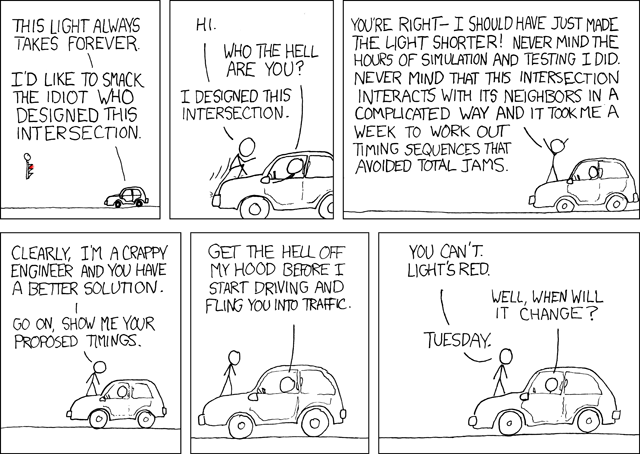Particularly, with a mildly satirical tone, I wanted to look into the phenomenon of clustering. In other words, I wanted to answer two questions:
- "Why do I always seem to miss buses in pairs?", and
- "Every time I try to ride the bus, why do I always get the full one?"
 To understand what I mean, let's assume:
To understand what I mean, let's assume:- A bus route to a main station has five equally distanced stops A, B, C, D and E.
- The distance between stops (described as time to traverse from one stop to another) is 2 minutes regardless of traffic and other factors.
- It takes 2 minutes to load a bus at each stop regardless of number of passengers, unless there are no passengers (or the bus is full) in which case the bus travels "express mode" and doesn't stop at all.
- A bus can hold 50 people maximum.
- That each stop has 15 people (total 75). It will take 2 buses to pick up all the passengers.
Notice that whatever the interval between buses (say 15 minutes) is the minimum wait time that the passengers at D and E have to wait for the second bus (on top of normal travel time if they could get one bus 1).
The travel time for each group is as follows:
Bus 1 (containing Passengers from A, B, C and 5 from D) arrives at the terminal after 18 minutes
Time = 2 min per stop x 4 stops
+ 2 min drive time between 5 stops
Bus 2 (containing the remaining passengers from from D and E) arrives at the terminal after 29 minutes
Time = 2 min per stop x 2 stops
+ 2 min drive time between 5 stops
+ 15 minute delay between Bus 1 and 2
Generally,
Travel time for any given bus = time spent picking up passengers (delay per stop x number of stops)
+ time spent driving between stops (travel time per stop x number of stops)
+ time delay between buses (anticipated wait time for a passenger who 'just missed the bus')
Notice that in this model, a bus that follows another will have a more "efficient route" excluding the delay time between the buses (currently set at 15 minutes) if the delay is less than 11 min, Bus 2 arrives before Bus 1! This is because Bus 1 (assumed to have "first dibs" on the passengers) will be held up in "transactions" picking up passengers.
Scenario ii What would happen in an incremented step by step analysis (if the two buses left at the same time) is as follows:
- Bus 1 picks up all passengers at A (2 min) while at the same time
Bus 2 travels to stop B (4 min). - Bus 2 picks up all passengers at B (2 min) while at the same time
Bus 1 travels to stop C from A (4 min). - Bus 1 picks up all passengers at C (2 min) while at the same time
Bus 2 travels to stop D from B (4 min). - Bus 2 picks up all passengers at D (2 min) while at the same time
Bus 1 travels to stop E (4 min). - Both buses run "express" to the terminal
Both Buses 1 and 2 arrive after 12 min (they share the load equally). This is what happens during non-rush hours and I would describe as "clustering", the phenomenon where buses (even when they start at different times) start to travel together.
As you can tell, this is a horrible situation when it comes to urban planning. For most lines, this means that even if you deliberately stagger buses so that they are 15 minutes apart (assuming that this is also the minimum amount of time someone would have to wait between buses), the truth is that with clustering on non-rush hours it is more likely the wait will be double that (because one bus will naturally catch up with the other if there isn't enough traffic). Hence the answer to: "Why do I always seem to miss buses in pairs?" is because they have a natural tendency to cluster.
Also, implementing queuing and network traffic theory, you can use the analogy that each bus stop is a server node and each bus is a service arrival.
This shows, as in the first scenario (Scenario i), that buses that lead are full. Assuming that occasionally when a few people get off at later stops (rather than waiting for the terminal) this is the only circumstance when a bus frees up more capacity to take on more passengers (also why they ask people to leave from the rear and board from the front). Hence the answer to: "Every time I try to ride the bus, why do I always get the full one?" is because during rush hour, most buses are full to capacity and only buses with marginal capacity available (almost full) stop to pick up more passengers.
Now the system described here only describes an oversimplified one line system. Imagine multiple inter-related lines, time sensitive with daily cyclical traveler arrival patterns, complicated with traffic congestion, traffic lights, construction and other "features" interacting on the road. You certainly can't just throw more buses into the system if you want to improve performance. And we can certainly sympathize with both the Traffic Engineer as well as the person in the car in this xkcd comic:







1 comment:
Very interesting post!
Perhaps if they forced vehicles to always have the same gap – for instance a bus stays a bit longer at a stop because the bus ahead of it is lagging this could be avoided. Perhaps that’s why I love the subway so much!
Your post is reconfirmed by the fact that I’ve been caught on a super full bus that was PASSED by an emptier one that was behind us!!!!
Post a Comment